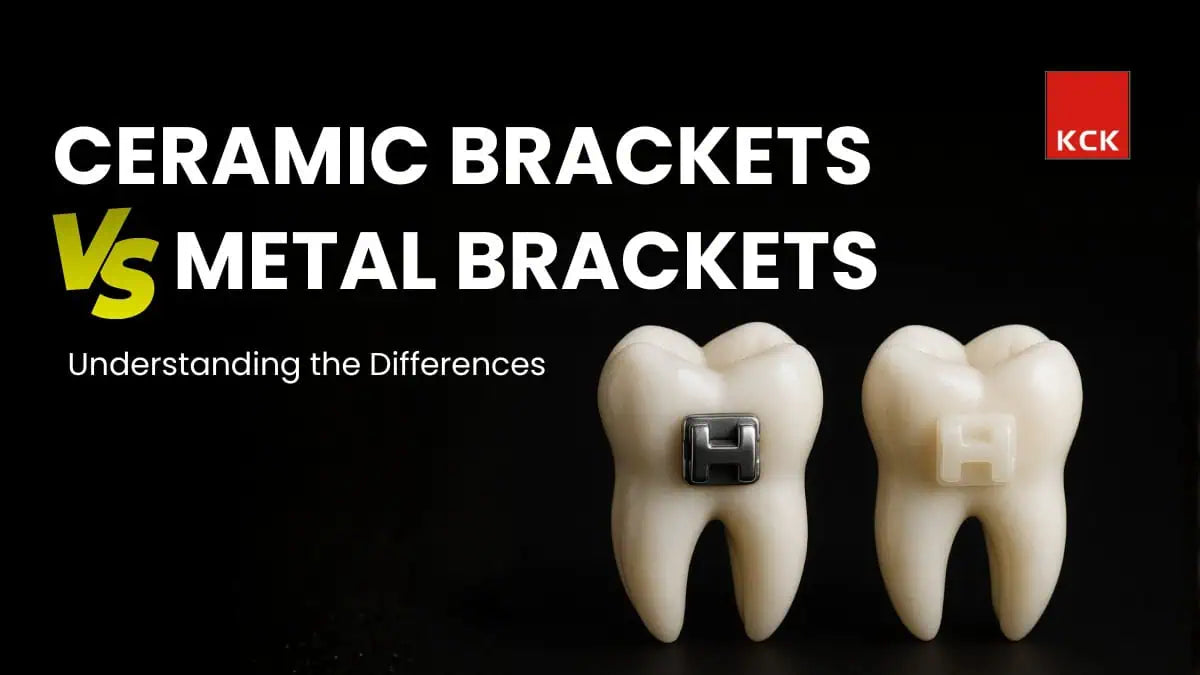Metal brackets and ceramic brackets are two types of orthodontic brackets used in dentistry to straighten teeth by applying controlled, gentle force to move them into better alignment.
Metal brackets are known for their superior durability, lower cost, and suitability for complex cases, while ceramic brackets are ideal for patients who prioritize a less visible, more aesthetic appearance. And they are stronger and more budget-friendly, whereas ceramic offers a more discreet look but is more fragile and may require higher maintenance.
When you turn the pages of dental history, you will find that archaeological evidence shows civilizations in ancient Egypt and Rome used crude metal bands made of gold and other precious metals to straighten teeth, dating back as far as 400-300 BCE.
Ceramic brackets, made from advanced materials, were officially introduced to the market in 1987. These clear or tooth-colored brackets provided a discreet alternative for patients concerned about the visibility of metal braces.
As dental students, understanding the differences between metal and ceramic brackets will help you choose the best option for your future practice.
Are you ready to delve into the topic? Let’s go!
What are Metal Brackets?
Metal brackets are small, square parts used in traditional braces to straighten teeth and fix bite problems. Each bracket is glued to a tooth and holds the archwire, which applies gentle pressure to move the teeth into the right position over time. The orthodontist adjusts the wire during visits to guide the teeth into proper alignment.
These brackets are usually made from stainless steel or titanium, making them strong and long-lasting. Metal brackets are very effective, affordable, and work well even for complex orthodontic cases. However, they are more visible than other types and may sometimes cause slight irritation inside the mouth.
Modern metal brackets are smaller, smoother, and more comfortable than ever before. Although ceramic and plastic brackets were later introduced for a more aesthetically pleasing look, metal brackets remain the most reliable and widely used choice in orthodontic treatment.
What are Ceramic Brackets?
Ceramic brackets are clear or tooth-colored braces made from a strong, see-through material called aluminum oxide (alumina). They work similarly to traditional metal braces, using an archwire to apply gentle, steady pressure that gradually moves the teeth into their correct position.
Ceramic brackets are mainly made from aluminum oxide and sometimes from zirconia. There are two main types: polycrystalline alumina, which has a tooth-colored or opaque look, which is clear and transparent, and monocrystalline alumina, which is clear and transparent.
Many older teens and adults prefer ceramic brackets because they are tooth-colored, aesthetically pleasing, and more comfortable than metal ones. However, they can be more fragile, may stain over time, and usually come at a slightly higher cost.
If you’re a first-year dental student and wondering about the difference between metal and ceramic brackets, check the comparison table below for a clearer understanding.
Difference Between Metal and Ceramic Brackets
|
Feature |
Ceramic Brackets |
Metal Brackets |
|
Material |
Made from ceramic (alumina) or zirconia |
Made from stainless steel or alloys |
|
Appearance |
Tooth-colored or clear, less noticeable |
Silver-colored, very visible |
|
Durability |
More fragile, can chip or break |
Very strong and durable |
|
Comfort |
Smooth on teeth, less irritating |
May feel slightly rough on cheeks/lips |
|
Cost |
More expensive |
More affordable |
|
Friction |
Higher with archwire |
Lower, smoother movement |
|
Bonding Strength |
Strong but may risk enamel on debonding |
Optimal bond strength |
|
Treatment Time |
Slightly longer in some cases |
Usually faster due to stronger material |
|
Maintenance |
Require careful cleaning |
Easier to clean and maintain |
|
Staining |
Can stain if not cleaned properly |
Rarely stains |
|
Clinical Handling |
Requires careful torque control |
Easier to adjust |
|
Best Suited For |
Esthetic anterior cases |
All cases, especially complex ones |
Advantages and Disadvantages of Ceramic Braces Vs Metal Braces
|
Bracket Type |
Advantages (Clinical & Educational Focus) |
Disadvantages (Clinical Challenges) |
|
Metal Brackets |
|
|
|
Ceramic Brackets |
|
|
Clinical Considerations & Summary for Dental Students
Understanding bracket selection is an important skill for every dental student and early orthodontic practitioner. The type of bracket you choose, metal or ceramic, can affect treatment efficiency, patient comfort, and clinical outcomes.
For beginners, learning how different brackets behave in various cases helps build good clinical judgment. The right choice depends on several factors such as case type, esthetic needs, and your learning stage. Developing this understanding early prepares you to handle more complex orthodontic cases in the future.
Clinical Insights for Bracket Selection
This section explains the key clinical factors that influence how and why a dentist chooses between metal and ceramic brackets.
Key Clinical Considerations
-
Case Complexity
Choose metal brackets for complex or high-force cases, as they offer more strength and control. Ceramic brackets may not handle heavy tooth movement or difficult alignments as effectively. -
Esthetics and Patient Type
Ceramic brackets suit patients who care about appearance and want less visible braces. Metal brackets are better for those who value function and lower cost over looks. -
Torque Control & Friction
Metal brackets usually provide smoother movement and better torque control because they create less friction with the archwire. Ceramic brackets may slow tooth movement due to higher friction. -
Bonding and Debonding
Metal brackets bond securely and are easier to remove with less risk of enamel damage. Ceramic brackets need more care during debonding because they are brittle and can crack or damage enamel if handled roughly. -
Learning Curve & Handling
Beginners often find metal brackets easier to handle and adjust during treatment. Ceramic brackets require gentler handling and more precision, which may be challenging for new dentists..
Clinical Summary Table
|
Clinical Scenario |
Recommended Bracket Type |
Notes / Rationale |
|
Severe crowding, skeletal discrepancy, or an extraction case |
Metal Brackets |
Metal brackets are stronger and handle heavy forces better. They allow smoother tooth movement and are less likely to break during complex treatments. |
|
Mild to moderate malocclusion with esthetic concern |
Ceramic Brackets |
Ceramic brackets look tooth-colored and are less visible, making them a good choice when appearance matters. |
|
Mixed aesthetic and functional demand |
Combination of Ceramic (front) and Metal (back) |
This setup balances appearance and strength; ceramic brackets in the front improve looks, while metal ones at the back add durability. |
|
Undergraduate or training clinic |
Metal Brackets |
Metal brackets are more cost-effective, easier to handle, and more forgiving for beginners during bonding and debonding. |
|
Adult patients with an anterior focus |
Ceramic Brackets |
Adults often prefer ceramic brackets for a clean, aesthetic look, especially when only the front teeth need correction. |
Which Type Should You Choose? Metal or Ceramic Braces?
Knowing these clinical points helps dental students choose the right brackets for each case and build confidence in their orthodontic skills. Both metal and ceramic brackets are important in learning and daily practice; the best choice depends on the type of case, skill level, and patient needs.
For new dentists, it’s best to start with metal brackets to learn the basics, such as bonding, wire changes, and tooth movement. Once you gain experience, you can move to ceramic brackets to handle esthetic cases and refine your technique. Learning both systems helps you become more flexible and skilled in your practice.
Get High-Quality Brackets with KCK Direct
If you’re looking for reliable orthodontic brackets and dental tools, KCK Direct is a trusted online store in India. All products are CSDESCO-registered and ISO-certified, meeting international standards. You can easily order online, keep your clinic stocked with quality instruments, and provide safe, efficient care for your patients.
|
Final Takeaway: Understanding and practicing with both bracket types helps students and young dentists build strong clinical judgment and deliver better orthodontic results. |
FAQs
What is the primary learning difference between metal and ceramic brackets?
Metal brackets are easier for beginners. They are strong, flexible, and simple to adjust. Ceramic brackets need gentler handling as they can crack easily. They’re better for students who already understand bracket mechanics and force control..
Do ceramic brackets affect tooth movement speed?
Yes, slightly. Ceramic brackets create more friction with the archwire, which can slow down movement a bit. Modern ceramic brackets with metal slots reduce this problem.
How can clinics manage ceramic bracket inventory efficiently?
Clinics can manage ceramic bracket inventory by keeping brackets organized by type, size, and tooth position, and tracking stock with spreadsheets or inventory software. Regular checks and a small safety stock prevent shortages and delays. For practical tips, refer to A Beginner’s Guide to Managing Inventory of Orthodontic Appliances, which explains how clinics can streamline inventory and reduce waste.
Are ceramic brackets compatible with self-ligating systems?
Yes. Ceramic self-ligating brackets exist and work like metal ones, but they are more fragile, so careful handling during placement and adjustment is needed.
What precautions are needed while debonding ceramic brackets?
Use the right pliers, apply gentle force, and peel off the bracket slowly. Clean any leftover adhesive carefully and check for enamel damage afterward.
What are common bonding failures seen in ceramic brackets?
They can crack, detach, or cause adhesive failure if handled roughly. Proper bonding technique and gentle force reduce these issues.
What sterilization protocols should be followed before bracket bonding?
Always use sterilized instruments and autoclave all tools before bonding to maintain infection control and patient safety. We have many types of autoclaves in dentistry; use the relevant one accordingly.
What’s the main challenge of ceramic brackets during clinical practice?
The main challenge is their fragility. They can break during bonding or wire changes. They also create more friction, which slightly slows treatment.
What mistakes should beginners avoid during ceramic bracket debonding?
Avoid pulling too hard or using the wrong pliers. Debond slowly and clean the adhesive carefully to prevent enamel damage.
Can ceramic brackets be reused for study purposes?
Yes, for training only. After cleaning and sterilizing, they can be reused for practice in bonding and wire adjustments, not for real patients.
How do you choose between ceramic and metal brackets for a new clinic setup?
It depends on your clinic’s goals, the type of cases you handle, and your patients’ needs.
Start with metal brackets; they’re strong, affordable, and work well for most orthodontic cases. As your clinic grows, you can add ceramic brackets for adults or patients who prefer a more aesthetic option.
If you’re setting up a new dental clinic, KCK Direct can help you with the right brackets, dental instruments, and equipment. We also provide turnkey clinic setup solutions to help you start your practice smoothly and professionally across Kerala..


